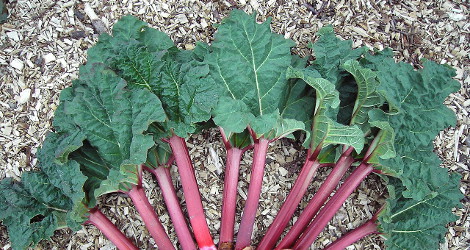Accession Data:
Rheum rhabarbarum L.
- Common Name: Garden Rhubarb
- Family: Polygonaceae Juss.
- Country of Origin: northern Europe
- Description: Plants 3-20(-30) dm. Stems striate, often striped or suffused with red or pink, branched distally, hollow. Leaves: ocrea brown, loosely funnelform, 2-4 cm, margins strongly oblique, glabrous or puberulent with flattened, whitish hairs along veins; petioles of basal leaves pinkish green or reddish green, ca. equaling or longer than blade, thick, fleshy, those of cauline leaves absent distally; basal leaf blades palmately veined with 5-7 basal veins, 30-45(-60) × 10-30 cm, veins pubescent primarily along veins with flattened, whitish hairs. Inflorescences 250-500-flowered, 15-40 cm; peduncle 1-8 cm, glabrous. Pedicels articulated at or proximal to middle, 2-5 mm, glabrous. Flowers: tepals oblong-ovate, 2.3-4 × 1-2.5 mm, margins hyaline, apex obtuse. Achenes 6-10(-12) × 6-11 mm including wings, 4-8 times longer than calyx and corolla of a flower (generally used when the two are similar).">perianth; wings tan, veined, 3-4 mm wide, membranous. 2n = 44. 1
- Uses: In traditional Chinese medicine, this root is known as Da Huang. This root is used as a strong laxative to expel stagnant waste within the body. Used with fever, constipation, and abdominal pain. Da Huang clears heat from the the blood and is therefore dangerous to use when blood deficiency is present.
This has also been used externally on burns, sores and cuts.
- IMPORTANT NOTE: Plant Uses are for informational purposes only. EEB Greenhouses assume no responsibility for adverse effects from the use of any plants referred to on this site. Always seek advice from a professional before using any plant medicinally.
- USDA Zone: 3a-8b
Accession Data:
- Accession # 201000185
- Source: EEB Garden
- Accession Date: 12-15-2010
- Bench: 5000 - Garden - TBD
- Currently: dormant
- Qty: 1 confirmed on 01-31-2024
- Restrictions:
- Poisonous Plant Parts - Not for Human Consumption
- Poisonous Plant Parts - Not for Human Consumption
Classification:
- Division: Magnoliophyta
- Class: Magnoliopsida
- SubClass: core eudicots
- Order: Caryophyllales
- SubOrder:
- Family: Polygonaceae
- SubFamily: Polygonoideae
- Tribe: Rumiceae
- SubTribe:
References (internal):
References (external):
- Description from Flora of North America
- The Plant List (2013). Version 1.1. Last accessed on Thursday, December 07, 2017.
- Rheum rhabarbarum. (2012, September 24). Wikispecies, . Retrieved 13:39, October 29, 2013
- Image #00 (cropped) & #01 (original) by Dieter Weber (User:Uellue) (own work, photo taken in a private garden in Kiel) [GFDL, CC-BY-SA-3.0 or CC BY-SA 2.5-2.0-1.0], via Wikimedia Commons. Last accessed on Thursday, December 07, 2017.
- Rheum rhabarbarum at ARS-GRIN. Last accessed on Thursday, December 07, 2017.
data regenerated on Tue, 08 Oct 2024 12:02:45 -0400 [bcm v4.0]
Images:

Additional images for this accession:
Click on thumbnails to enlargeCurrent Accessions in the Polygonaceae
Subfamily Eriogonoideae
Subfamily Polygonoideae
Tribe Polygoneae
- Reynoutriinae: Fallopia aubertii
- Reynoutriinae: Homalocladium platycladum


- Reynoutriinae: Muehlenbeckia complexa


Subfamily Polygonoideae
Tribe Rumiceae
W/C = Wild Collected
 = indicates flowering in past 14 days
= indicates flowering in past 14 days
 = images available for this accession
= images available for this accession
 = map available for this accession
= map available for this accession
 = accession added within past 90 days
= accession added within past 90 days
